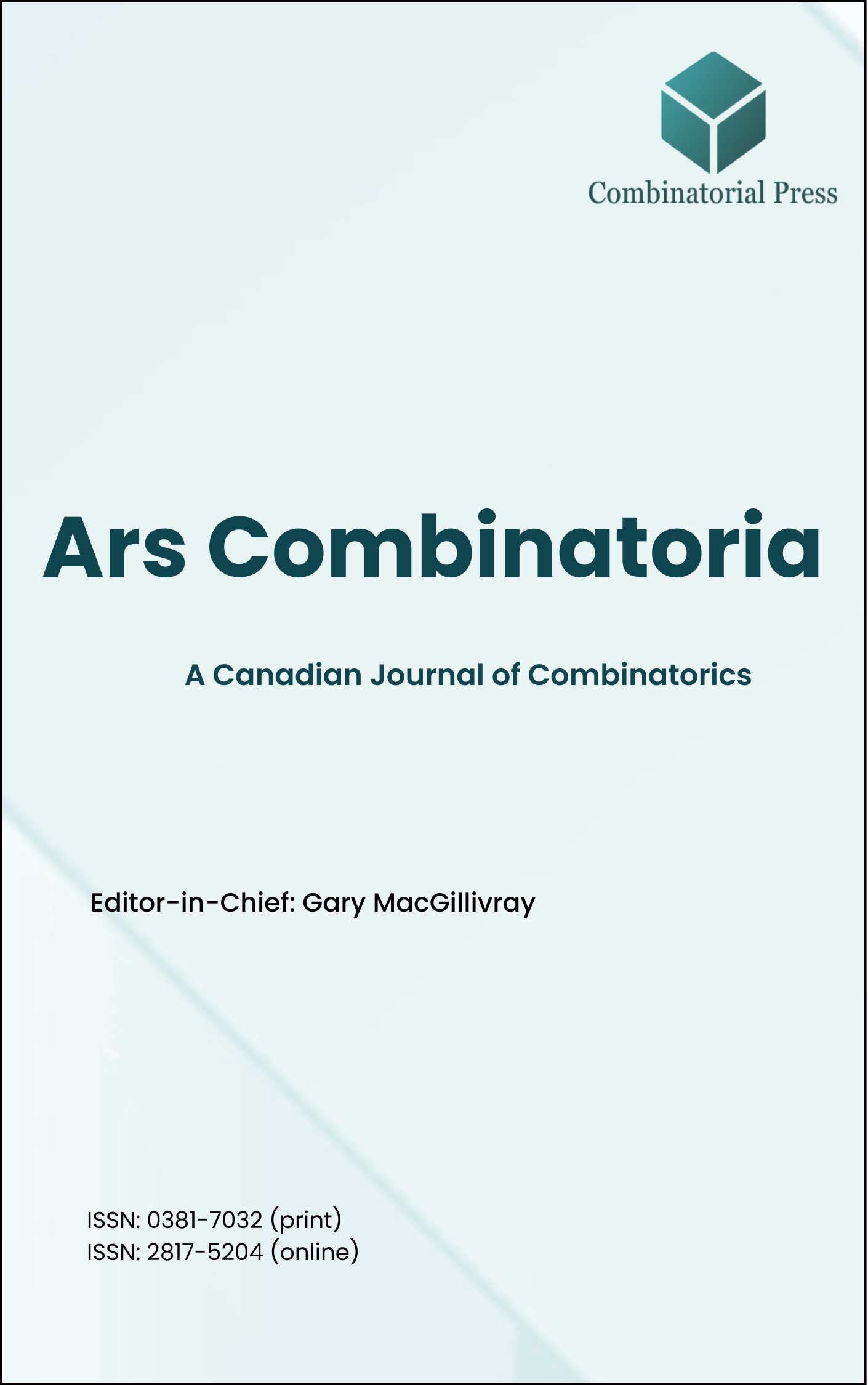
Ars Combinatoria
ISSN 0381-7032 (print), 2817-5204 (online)
Ars Combinatoria is the oldest Canadian Journal of Combinatorics, established in 1976. The journal is dedicated to advancing the field of combinatorial mathematics through the publication of high-quality research papers. From 2024 onward, it publishes four volumes per year in March, June, September and December. Ars Combinatoria has gained recognition and visibility in the academic community and is indexed in renowned databases such as MathSciNet, Zentralblatt, and Scopus. The Scope of the journal includes Graph theory, Design theory, Extremal combinatorics, Enumeration, Algebraic combinatorics, Combinatorial optimization, Ramsey theory, Automorphism groups, Coding theory, Finite geometries, Chemical graph theory but not limited.
Information Menu
- Research article
- Full Text
- Ars Combinatoria
- Volume 044
- Pages: 173-181
- Published: 31/12/1996
Eight new codes are presented which improve the bounds on maximum minimum distance for binary linear codes. They are rate \(\frac{m-r}{pm},r\geq 1\) , \(r\)-degenerate quasi-cyclic codes.
- Research article
- Full Text
- Ars Combinatoria
- Volume 044
- Pages: 161-172
- Published: 31/12/1996
A method for synthesizing combinatorial structures which are members of an extended class of resolvable incomplete lattice designs is presented. Square and rectangular lattices both are realizable, yet designs in the extended class are not limited in number of treatments by the classically severe restriction \(v = s^2\) or \(v = s(s-1)\). Rather, the current restriction is the condition that there exist a finite closable set of \(k\)-permutations on the objects of some group or finite field, which is then used as the generating array for a \(L(0,1)\) lattice design. A connection to Hadamard matrices \(H(p,p)\) is considered.
- Research article
- Full Text
- Ars Combinatoria
- Volume 044
- Pages: 149-160
- Published: 31/12/1996
Near-perfect protection is a useful extension of perfect protection which is a necessary condition for authentication systems that satisfy Pei-Rosenbaum’s bound. Near-perfect protection implies perfect protection for key strategies, defined in the paper, in which the enemy tries to guess the correct key. We prove a bound on the probability of deception for key strategies, characterize codes that satisfy the bound with equality and conclude the paper with a comparison of this bound and Pei-Rosenbaum’s bound.
- Research article
- Full Text
- Ars Combinatoria
- Volume 044
- Pages: 137-148
- Published: 31/12/1996
This note gives what is believed to be the first published example of a symmetric \(11 \times 11\) Latin square which, although not cyclic, has the property that the permutation between any two rows is an \(11\)-cycle. The square has the further property that two subsets of its rows constitute \(5 \times 11\) Youden squares. The note shows how this \(11 \times 11\) Latin square can be obtained by a general construction for \(n \times n\) Latin squares where \(n\) is prime with \(n \geq 11\). The permutation between any two rows of any Latin square obtained by the general construction is an \(n\)-cycle; two subsets of \((n-1)/2\) rows from the Latin square constitute Youden squares if \(n \equiv 3 \pmod{8}\).
- Research article
- Full Text
- Ars Combinatoria
- Volume 044
- Pages: 129-135
- Published: 31/12/1996
The twenty-five year old \(\lambda\)-design conjecture remains unsettled. Attempts to characterize these irregular, tight, \(2\)-designs have produced a great number of parametric and dual structure characterizations of the so-called Type-I Designs. We establish some new structural characterizations and establish the conjecture in the smallest unsettled case (\(\lambda = 14\)) of the \(2p\) family.
- Research article
- Full Text
- Ars Combinatoria
- Volume 044
- Pages: 119-127
- Published: 31/12/1996
In this paper we consider a random walk in a plane in which a particle at any stage moves one unit in any one of the four directions, namely, north, south, east, and west with equal probability and derive the joint and marginal distributions of certain characteristics of this random walk by using combinatorial methods.
- Research article
- Full Text
- Ars Combinatoria
- Volume 044
- Pages: 97-118
- Published: 31/12/1996
A subset \(S\) of an ordered set \(P\) is called a cutset if each maximal chain of \(P\) has nonempty intersection with \(S\); if, in addition, \(S\) is also an antichain, it is an antichain cutset. We consider new characterizations and generalizations of these and related concepts. The main generalization is to make our definitions in graph theoretic terms. For instance, a cutset is a subset \(S\) of the vertex set \(V\) of graph \(G = (V, E)\) which meets each extremal path of \(G\). Our principal results include (1)a characterization, by means of a closure property, of those antichains which are cutsets;(2) a characterization, by means of “forbidden paths” in the graph, of those graphs which can be expressed as the union of antichain cutsets;(3) a simpler proof of an existing result about \(N\)-free orders; and (4) efficient algorithms for many related problems, such as constructing antichain cutsets containing or excluding specified elements or forming a chain.
We include a brief discussion of the use of antichain cutsets in a parsing problem for \(LR(k)\) languages.
- Research article
- Full Text
- Ars Combinatoria
- Volume 044
- Pages: 93-96
- Published: 31/12/1996
The \(n\)-star graph \(S_n\) is a simple graph whose vertex set is the set of all \(n!\) permutations of \(\{1,2,\ldots,n\}\) and two vertices \(\alpha\) and \(\beta\) are adjacent if and only if \(\alpha(1) \neq \beta(1)\) and \(\alpha(i) \neq \beta(i)\) for exactly one \(i\), \(i \neq 1\). In the paper, we determine the values of the domination number \(\gamma\), the independent domination number \(\gamma_i\), the perfect domination number \(\gamma_p\), and we obtain bounds for the total domination number \(\gamma_t\) and the connected domination number \(\gamma_c\) for \(S_n\).
- Research article
- Full Text
- Ars Combinatoria
- Volume 044
- Pages: 65-92
- Published: 31/12/1996
Holey factorizations of \(K_{v_1,v_2,\ldots,v_n}\) are a basic building block in the construction of Room frames. In this paper we give some necessary conditions for the existence of holey factorizations and give a complete enumeration for nonisomorphic sets of orthogonal holey factorizations of several special types.
- Research article
- Full Text
- Ars Combinatoria
- Volume 044
- Pages: 55-64
- Published: 31/12/1996
It is shown that the maximal number of pairwise edge disjoint forests, \(F\), of order six in the complete graph \(K_n\), and the minimum number of forests of order six, whose union is \(K_n\) are \(\lfloor\frac{n(n-1)}{2e(F)}\rfloor\) and \(\lceil\frac{n(n-1)}{2e(F)}\rceil\), \(n\geq 6\), respectively and \(e(F)\) is the number of edges of \(F\). (\(\lfloor x\rfloor\) denotes the largest integer not exceeding \(x\) and \(\lceil x\rceil\) the least integer not less than \(x\)). Some generalizations to multiple copies of these forests and of paths are also given.





